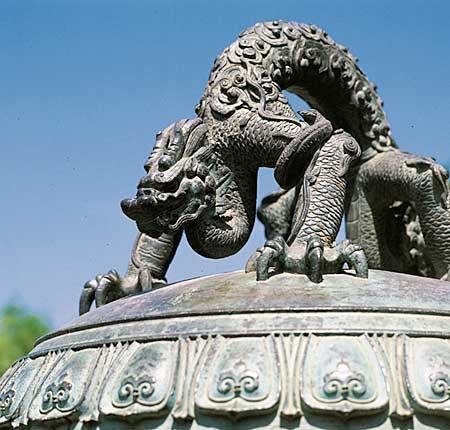
 |
| The refined casting Qianlong Bell is a precious ancient relic and the dragon with two heads embracing the bell is a symbol of imperial power, showing dignity. (CNTV) |
An imperial palace surrounded by a moat located in the west gate of the inner altar is known as "the Hall of Abstinence," and is where the emperors lived while they fasted before offering sacrifices. The palace has the Beamless Hall, the Resting Hall, the Bell Tower and some other buildings and covers an area of 4 hectares. The Divine Music Administration for management of sacrificing music and dance and the Department for Sacrifices for rearing slaughtered sacrifices are subsidiary buildings and are located in the west of outer altar.
Heritage value:
The ancient altar architectural complex has a high historical value, scientific value, unique artistic value and even profound cultural connotations.
The design and construction of the Temple of Heaven had concentrated the quintessence of architectural technology and art in the Ming and Qing dynasties. The Hall of Prayer for Good Harvest and the Imperial Vault of Heaven are large, refined and cleverly designed palaces with wooden constructional elements and a circular plane, and are seldom seen in Chinese ancient architectures. With a large area of trees and rich vegetation, the Temple of Heaven has created a harmonious ecological environment. It is an example of studying ancient architecture and ecological environment, and has great scientific value and is an outstanding example of imperial altar buildings.


















 Wild Siberian tiger kills cattle in NE China
Wild Siberian tiger kills cattle in NE China


![]()
